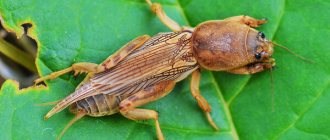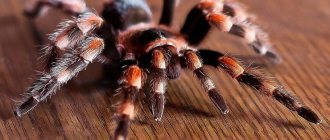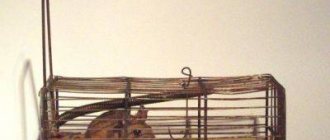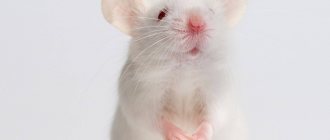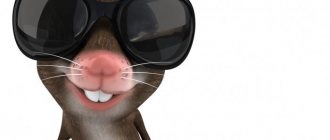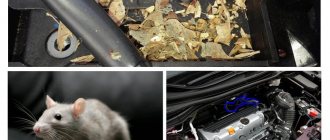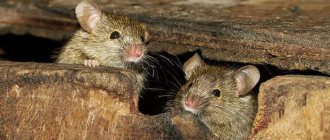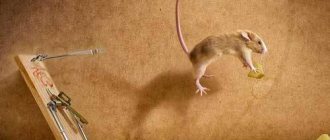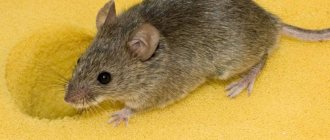For some, the small gray animal causes disgust, for others it causes tenderness. But whether a person wants it or not, the mouse is his constant companion. So why not get to know this animal better? How long do mice live? How do they triple their homes? What do they eat and how do they reproduce? How to choose a pet and provide it with comfortable conditions?
- Class: Mammals;
- Order: Rodents;
- Suborder: Mouse-like;
- Family: Mice;
- Subfamily: Mouse.
Mouse - description and external characteristics
These small rodents are distributed throughout the entire earth, excluding the extreme northern and high-mountain regions. The closest relatives of mice are jerboas, mole rats, hamsters and dormice. And more distantly related are rats, chinchillas, porcupines, beavers, and guinea pigs. In total, the Mouse subfamily includes 121 genera and more than 300 species.
The mouse is a small animal with an elongated and pointed muzzle, large round ears and bulging beady eyes. A long, hairless or slightly furred tail is a distinctive feature of the animal. The limbs, which are not the same in length, are adapted for digging and moving along vertical and horizontal surfaces. The body length of a rodent can vary from 3 to 20 cm, weight - from 15 to 50 g.
Mice have a special bite. On the lower and upper jaws the animal has 2 chisel-shaped teeth, which are continuously growing. Rodents are forced to constantly grind them down, which is why their incisors are very sharp.
Animals from the Mouse family have good eyesight and can distinguish between red and yellow shades. The usual body temperature of these rodents ranges from 37.5 to 39⁰C. The maximum lifespan of mice is 4 years.
Behavior and intelligence
The house mouse is the most common rodent living in human housing. Over many years of coexistence, its diet has changed significantly; the animal switched from cereals and nuts to plant and animal products that people eat. In the summer, mice can live in the fields, picking up grains, but by mid-autumn they will certainly move closer to humans and a warm home.
The intelligence of house mice is quite low, they are also not very careful, so they easily fall into even the simplest mousetraps. The population of these rodents is maintained only due to their rapid reproduction - females give birth to offspring every month, up to 100 mice per year
Their body length is 7-8 cm, in rare cases with good nutrition - up to 10 cm, weight - 25-40 grams. Thanks to such miniature dimensions, the mouse is able to squeeze through even a centimeter gap.
Mice are very cowardly animals; at the slightest rustle they quickly disappear from sight. At the same time, they can calmly run out into the middle of the room if the person sits quietly and moves little.
If this rodent is caught at the scene of a crime, it will freeze, assess the situation and run away only if it sees danger. Catching a rat with your hands or throwing a blanket over it is not a good idea. They are aggressive and will fiercely defend themselves if they find themselves in a hopeless situation.
Mice live in houses much more often; thanks to their small size, it is easier for them to enter a room, hide and get the right amount of food. Rats prefer to settle in places where people visit less often: in basements, granaries, barns, chicken coops.
Mice and rats cannot coexist in the same area. When the pasyuks arrive, one part of the small rodents immediately changes their place of residence, and the other turns out to be food for their older brothers.
How mice behave in their natural environment
In order for rodents to maintain a constant body temperature, they need to be active in winter and summer, day and night. Gluttony and fussiness for mice are characteristic traits that help them survive and leave offspring.
In the fall, animals begin collecting provisions in a burrow or on the surface of the ground, where the “warehouse” is camouflaged with earth. And if in the off-season rodents are awake at night and sleep during the day, then in winter they remain active around the clock. In spring and autumn, when there is no shortage of food and no temperature fluctuations, mice actively reproduce.
Mice live in large families, since together it is easier for them to defend themselves, get food, build homes, and raise offspring. In a mouse pack there is a leader who maintains order in the group. Female mice are peaceful. But young males do not always put up with their subordinate position. Stomping with its hind legs and aggressive tail strikes indicate the animal’s intention to conquer the “throne.” Inter-family clashes can lead to the disintegration of the pack.
What to do if a bat flies into the house?
Bats can live within the city and in the suburbs, but since they lead a very secretive lifestyle, we hardly notice them. The likelihood that an animal will fly into an apartment is small, but it still happens. With the onset of autumn, bats look for reliable shelters for wintering, and they usually spend the winter in caves. Our houses are essentially artificial caves for them. Therefore, sometimes they can stop by to see us.
What to do if a bat flies into your house or apartment?
First of all, don't panic! The animal is no less frightened than you are, and under stress it may bite.
Do not try to catch the uninvited guest - you may injure her, or worse, she may hide in a hard-to-reach crevice and die there.
If the animal flew into the house during the warm season, just wait until evening and open the curtains and windows. When darkness falls, the mouse will leave your home on its own.
Do not allow the winged mouse to come into contact with your pets - this can lead to injury to the animals.
If you still need to pick up the bat (for example, it is on the floor), put on thick gloves, pick up the animal and release it.
Where do mice live in the wild?
Mice spend most of their time in burrows, raising offspring, escaping danger, storing food, or resting after eating it. The maximum depth of the burrow is 70 cm, and the total length of the passages can reach 20 m. Some species of mice build nests in thickets of tall grasses (little mouse) or live in tree roots and old stumps (forest mouse).
Minks can be temporary or permanent, and the latter can be summer or winter. Temporary housing for animals is simply planned. The permanent mouse hole has a spacious nesting chamber and several entrances. In summer burrows where rodents give birth, bedding is created from fluff, blades of grass, shavings and feathers. And in winter, a pantry is set up for food supplies.
What does a mouse eat in the wild?
In summer and autumn, when the time comes for the harvest to ripen, mice begin to actively prepare food reserves for winter. The main food of the animals is grain crops, as well as seeds of various plants. Field mice love wheat, barley, oats, and buckwheat.
Rodents living in forests feed on cedar and hazel nuts, maple and beech seeds, acorns, and small insects. And animals living near bodies of water prefer to eat leaves, roots and stems of plants, berries, grasshoppers, caterpillars, larvae, spiders and other invertebrates. House mice living near people willingly adapt to the human diet and eat bread, meat, dairy products, and sweets.
Animals living in the wild drink very little. The mouse body independently produces water by breaking down food. Additional sources of moisture are fleshy plant leaves, fruits, and vegetables.
Enemies of mice
The mouse is a key link in the food chain of many ecosystems. Many wild animals depend on the existence of this small rodent. For mice living in the forest, the main enemies are foxes, martens, arctic foxes, ferrets, stoats, weasels, lynxes and even wolves. Predators easily tear apart burrows and can eat up to 30 small animals a day.
Mice are the main food for snakes and large lizards. Reptiles such as boas, pythons, vipers, and radiant snakes swallow their prey whole. During the hunt, the snake freezes, and then suddenly attacks the victim, biting it with poisonous teeth, and then waits for the animal to become motionless.
There is also danger lurking for mice from above. Among birds there are predators that differ in the power of their beaks, visual acuity and hearing. These are owls, buzzards, hawks, eagles, owls, kites. They hunt during the day or night, making swift attacks from the air.
Advantages and disadvantages
The mouse has become the main point-and-point input device due to the following features:
• Very low price (compared to other devices like touch screens).
• High accuracy of cursor positioning. With the mouse (with the exception of some “unsuccessful” models) it is easy to hit the desired pixel on the screen.
• The mouse allows many different manipulations - double and triple clicks, dragging, gestures, pressing one button while dragging another... Therefore, you can concentrate a large number of controls in one hand - multi-button mice allow you to control, for example, a browser without using the keyboard at all.
The disadvantages of the mouse are:
• Danger of carpal tunnel syndrome.
• To work, you need a flat, smooth surface of sufficient size (if there is none, you have to use mouse surrogates like mini-joysticks and touchpads).
• Mouse feet accumulate dirt and do not last long (for this reason, the mouse is practically not used in military devices).
• Drawing with a mouse is almost impossible due to the special reaction of the OS to mouse movements. If the user does not reduce the speed, the OS assumes that he wants to move the mouse far and speeds up the cursor movement. The problem is partially solved by a high-precision gaming mouse coupled with acceleration disabled; entirely using a graphics tablet.
How long do mice live?
The lifespan of rodents directly depends on environmental conditions. The average is 2-3 years. The greatest influence on the lifespan of animals is exerted by factors such as climate, nutrition, infectious diseases and attacks by wild animals.
Both frost and dry, hot weather can be detrimental to mice. Too sharp temperature fluctuations destroy numerous rodent colonies. Often the weather is related to the opportunity to eat well. An inadequate diet significantly shortens the life of a mouse.
Many species of mice that live away from people live a little less or more than a year. And an animal tamed by humans, receiving balanced nutrition and care, can live up to 6 years.
Reproduction in mice
The mouse is a polygamous animal. In nature, one male fertilizes from 2 to 12 females. Over 12 months, mice have from 3 to 8 litters. The female reaches sexual maturity 10 weeks after birth. At this time, she begins to go into heat, which lasts 5 days and is expressed in special behavior.
If after coating the female fails to become pregnant, a new estrus occurs within a week. If fertilization is successful, the female animal is expected to give birth in 17-24 days. There are from 3 to 9 cubs in one litter. Female mice give birth at night. Babies, when born, are unable to move, hear or see. They have no hair, and the size ranges from 2 to 3 cm. The little mice develop rapidly:
- 3 days - fluff appears on the body;
- 5 days - the cubs begin to hear;
- 7 days - the animal’s body weight doubles;
- 14 days - palpebral fissures appear;
- Day 19 - the mice begin to eat on their own;
- 25 days - the length of the body reaches 50 mm (the tail is 15-20 mm shorter) and the mouse is already sexually mature.
Decorative mice develop a little slower. It is recommended to mate them no more than 2-3 times a year. Repeated births exhaust the female, and each subsequent offspring becomes weaker.
Types of wild mice
Shrew or shrew mouse (Myosorex)
Animals from the shrew family are divided into only 14 species. This long-nosed mouse is small in size (6-10 cm). Only the born cubs weigh less than 1 g. The animal’s nose, curved at the end, is called the proboscis. The animal's coat is shiny, thick, and silky; There are gray, ocher, reddish shades.
A mouse with a long cute nose navigates in space thanks to its sense of smell. It is an omnivore, but prefers to eat insects, as well as some vertebrates (frogs, baby rodents, small reptiles). Without food, this animal can live no more than 10 hours.
Shrews live in large concentrations in South America, Africa, and Australia. This small mouse with a long nose feels great near bodies of water, in damp forests and low-growing thickets.
Japanese mouse (Sylvaemus mystacinus)
A mouse with large round ears and a long nose. It is also called Asia Minor. Inhabits the islands of Japan, southwestern Georgia, and the Kuril Islands of Russia. Prefers mountainous uplands, mixed forests, with dense shrubby undergrowth.
Japanese mice do not dig holes, inhabiting voids in trees and buildings, accumulations of stones and dense bushes. The length of the body and tail are almost equal (up to 13 cm). They breed only during the 6 warm months of the year, during which time they produce 2-3 litters of 3-6 cubs.
Wood mouse (Sylvaemus sylvaticus)
A distinctive feature of the animal is a yellow round spot on the chest. The length of the rodent is 12 cm, the tail is 7-10 cm. These mice can occupy abandoned holes, rotten stumps, voids under stones and other natural shelters. The wood mouse is especially common in Siberia, Western Asia, Altai, and in the deciduous forests of Ukraine, Belarus, and Moldova. It feeds on cereals, seeds, nuts, and insects.
Gerbil mouse (Gerbillidae)
In the Mouse gerbil family, gerbils are classified into a separate subfamily, numbering more than 100 species of animals. The natural habitat of these animals is the arid steppes of Eastern Europe, African and Asian deserts and semi-deserts. They are active during the daytime; In winter they do not hibernate, but their lifestyle becomes more sluggish.
Externally, the gerbil mouse looks more like a rat. The length of the animal can reach 20 cm and weight 250 g. The color of the animal is brownish-sandy on the back and lighter on the chest. A well-furred long tail falls off in dangerous situations, and a new one does not grow. The gerbil mouse can walk on its hind legs and jump over long distances (up to 4 m). It feeds on grains of wheat, barley, corn, millet, as well as fruits and nuts.
Little mouse (Micromys minutus)
The name of the genus is associated with the miniature size of the animal. The maximum body length of the animal is 7 cm, and the tail is 5 cm. The animal prefers to live in the steppe and forest-steppe, in grain fields, and in floodplain meadows. Among the grass you can find spherical houses of this rodent, made of dry stems and leaves.
The baby mouse is distinguished by its fiery red coloration of its skin, which appears after the first molt. It feeds on invertebrates, green leaves, and grains. The little mouse is peaceful, quickly adapts to a new environment, and therefore can be tamed by people.
White mouse (Mus musculus)
It is also called the house mouse or house mouse because the animal has adapted to live near humans. In living quarters, sheds, and storerooms, these rodents hide complex, multi-channel burrows, where they live in large colonies. Not far from their burrows, they make storage areas for food: seeds, nuts, crackers, pieces of vegetables.
The white mouse is not a large animal, its length reaches 8-11 cm. The long tail is covered with sparse hair, and scaly rings are clearly visible on it. The color of the animal’s skin depends on the species, but the fur on the back is darker than on the belly. The house mouse lives on all continents, in all climate zones and is a faithful companion to humans.
Grass mouse (Arvicanthis)
The length of the body of an individual, including the tail, can exceed 30 cm. The gray or brown fur consists of elongated soft hairs and stiff bristles, as well as hard spiked hairs in some species. Their rhythm of life is similar to that of humans - they are awake during the day and sleep at night.
The homeland of grass mice is Southeast Africa. These rodents love moisture and live mainly in river floodplains and in humid tropical plantations. They can both dig holes and occupy other people's homes.
Field mouse (Apodemus agrarius)
The field mouse is not like other rodents of the Mouse family. The animal has a clear, contrasting color stripe on its skin, which runs along the entire spine, from the muzzle to the base of the tail. The size of the animal varies from 8 to 12 cm without a tail. The color, depending on the species, can vary from light gray to dark brown and black. The field mouse builds its home on its own or uses suitable structures.
The field mouse inhabits the territories of Western and Northern Europe, as well as part of Asia: China, Sakhalin, Taiwan. The animal loves meadows and fields, in deciduous thickets, but is also found in the city. The field mouse feeds on invertebrate insects, cereals, plant stems and fruits.
How did the resettlement happen?
At first, the dispersal of mammals of the genus Mouse (domestic mice) from their original habitats proceeded spontaneously and naturally. Steppes, fields, and semi-deserts were native to these animals, but little by little people began to lead a sedentary lifestyle and mastered agriculture. And at the moment when man began to create his first granaries, rodents realized that they did not need to store food for the winter, they could simply move into the barn and spend the winter there quite comfortably. It was from this moment that the now generally accepted term “house mouse” began to have a real basis.
Since people mastered navigation, mice began to settle around the world on their own ships, all in the same holds designed for storing grain. Only the northern and southern parts of the globe were not subject to settlement by mice, since these animals are heat-loving and do not tolerate cold. But residents of other parts of the world have been cohabiting with house mice for many years. Only mice benefit from such cohabitation. For a person from such “cohabitation” there are only losses.
House mouse: choosing a pet
Decorative mice are friendly, non-aggressive, clean, quickly get used to their owners, and are very easy to care for. When choosing an animal, you should pay attention to the habits and appearance of the rodent. An animal in good health looks like this:
- the fur does not stick out, there are no bald patches;
- teeth white, straight;
- the animal has moist and shiny eyes;
- the animal does not have mucous discharge from the nostrils and eyes;
- The mouse is actively moving and feeding.
We must not forget how many years mice live. The maximum lifespan of these animals is 3-4 years, so it is better to choose a pet under the age of 12 months. You need to pay attention to the sex of the rodent, since several males will not get along in one home.
Males are slightly larger than females, their body resembles an elongated pear. A 30-day-old male mouse has formed testicles under its tail. And in the female, from the 3rd day after birth, 5 pairs of rudimentary nipples are clearly visible.
The house mouse is a collective animal, so it is better to purchase several individuals. If further breeding of animals is planned, then males and females must be kept separately until mating.
Varieties
There are different breeds of decorative mice. These include:
Micromys minutus (translated as “little mouse”) is the smallest mammal in Europe. The size of this rodent reaches 13 centimeters, and the tail and body are approximately the same length. The color of the back - from red to brown - is clearly distinguished from the color of the abdomen - white or light gray. They have a very mobile and grasping tail. The muzzle of these rodents, unlike their relatives, is shortened.
Gerbils. The second most popular breed, after baby mice. They are very similar to chipmunks because they have a body large enough for mice and a short drooping tail.
Spiny rodents. These mice look a little like hedgehogs. This is all because of their fur - it is shaped like needles. This breed is difficult to confuse with others, mainly because of the coat, but not only because of it. These mice also have very unusual ears and large black shiny eyes that look like beads.
Mice for keeping at home
Thanks to modern selection, ornamental mice have hundreds of species, among which there are singing, “waltzing”, and animals with unusual coat colors (white albino mice, pure black mice, ashy and cream-colored animals).
Some types of mice are especially popular:
- The Japanese dwarf mouse is very tiny, up to 5 cm long. The white skin is decorated with black and brown spots. Friendly, clean and energetic. Leads a nocturnal lifestyle. There are 5-7 mice in a litter.
- The spiny mouse or akomis is a large decorative mouse with many needles located along the entire back. The color is reddish-brown or blackish-red. The neck is framed by a voluminous fat hump. The nose is elongated, the eyes are bulging, the ears are large and oval in shape. The mouse is very active and quickly gets used to people.
- The decorative African striped mouse has an interesting coloring: light and dark stripes alternate along the body. The animal does not emit an unpleasant odor. It climbs well on vertical surfaces. The striped mouse is a very shy animal. In case of danger, it can pretend to be dead or jump to a height of up to 2.5 m. The body length rarely exceeds 10 cm.
Description
The house mouse is a mammal of the Mouse genus; this animal rarely grows in length more than 10 cm, the average length is 7-8 cm. They have a thin tail, the length of which reaches more than half the length of the main body. Unlike the body itself, the tail, instead of fur, is covered with horny scales, between which very sparse and short hairs grow. In most cases, all house mice are gray. There are lighter and darker shades, but ash gray is by far the most common color. Although there are also individuals with a gray-brown color, and even white ones. Desert mammals have a yellowish-sandy color. The fur on the abdomen of any variety of mouse is always paler.
Females have 5 nipples, these are the only clearly defined differences by gender. Each has rather long vibrissae (sensitive antennae in the front of the muzzle), black beady eyes and small, rounded ears.
Care and maintenance of mice at home
The house where decorative mice live can be a cage, an aquarium, or a transparent plastic box. For a small number of animals, a dwelling measuring 25*45*22 cm is sufficient. The bottom of the terrarium is covered with sawdust from fruit trees or hygienic filling made from corn, paper, or straw. Decorative rodents need to change their bedding at least once a week, but preferably every 3 days. The top of the terrarium is covered with a lid with holes for oxygen.
Several shelters are equipped inside the house, preferably at different heights. All types of mice are very active and run up to 40 km a day in their natural environment, so the terrarium should have a running wheel. You can supply water to rodents through a hanging drinking bowl or pour it into a small saucer.
A decorative mouse is an animal that easily gets cold and overheats. It is better to place the animal’s house away from the window, protect the cage from drafts and bright sunlight. The ideal temperature for these rodents is 20-22⁰С.
Animal mouse - everything about these rodents
The mouse is an animal known to mankind for hundreds of years. During this time, the animal went from a pest to a pet and an indispensable assistant for doctors. Even small children know what a mouse looks like.
Destruction Bitten, what to do How long do they live? Squeaks in the walls How to kill How to distinguish from a rat How to remove them from a cellar Protecting grapes in winter How to remove them from a car How to remove them from a garage How to fight Do they live in mineral wool Do they eat polystyrene Anatomy and physiology What kind of remedies are there What smells do they not like Traps Bait in a mousetrap Reproduction and childbirth Varieties What are they afraid of What do they eat at home How to protect apple trees in winter What diseases do Gnaws carry? ut polyurethane foam BlackrootKak catch without a mousetrapGluePoisonUltrasonic repellerHow to get rid of in the apartmentHow to get rid of in the houseBrownieVoleSeaJapaneseBlackLaboratorySpinousWith stripeThe largest ShrewForestBabyWhiteGerbilsDecorative
A mouse is an animal or mammal belonging to the rodent order. They are distributed all over the world. The sizes of the animals are small - from 4 to 12.5 cm. They are nocturnal. The mouse is a herbivorous rodent, only some dilute their diet with meat.
A living mouse is the causative agent of many diseases and harms the farm. Despite the fact that a mouse is a beast or animal that causes a lot of problems for people, these rodents will bring a lot of positive emotions as a pet. You can read about keeping mice in articles
It doesn’t matter where the mouse lives - in a cage or a plastic container, it will be a favorite of the whole family
We are in social networks
Survey
VetUgolok.ru 2015 - 2021. All rights reserved.
What do decorative mice eat?
All animals from the Mouse family are prone to obesity, so you need to know what the ornamental mouse eats. The basis of the animal’s diet is cereals: barley, wheat, corn, sorghum. The grain should not be ground. Usually house mice are very small and eat up to 1 tsp per day. stern.
The animals' favorite treats are sunflower seeds, pumpkin seeds, caraway seeds, walnuts, peanuts and hazelnuts. Vegetables and fruits are necessary in the animal's diet. It is better if the vegetables are green: cauliflower, lettuce, cucumber, zucchini, broccoli, parsley. And the fruits are not very sweet and juicy: apple, banana, quince, pear, plum. Occasionally you can give bread and egg whites.
What mice don’t eat: citrus fruits, smoked meats, meat, food for cats and dogs.
Characteristic features of life
It is believed that mice are quite timid by nature. This may be true, but if the mouse does not behave this way, then it will not survive, since it has a sufficient number of natural enemies.
In the wild, the mouse adapts to various conditions of its existence: it crawls, swims, digs holes in the ground, and some species have learned to fly. Such abilities of such a small mammal allow it to survive in such harsh natural conditions.
A mouse can build its nest anywhere - underground, in the hollows of old trees, in bird nests, under stones, etc. When she settles in a person’s house, her nest can be found under the floor, in the attic, in the basement, in the openings between the walls. The rodent goes hunting at night, but does not go far from its nest. During the daytime, mice sit quietly in their hiding places.
Interesting Facts! Some species of mice live in large packs, where the head of the pack is a male with several females. Each individual is responsible for its own territory, where it obtains food for itself. The offspring are raised by all females together, and after they reach “adulthood”, the young are expelled from the pack.
Mice wait out the winter in different conditions. For example:
- In the ground, in deep holes.
- In hay or straw stacks.
- In outbuildings for various purposes.
Mice that spend the winter in natural conditions store food supplies for the winter. To do this, rodents set aside special places in their burrows where they carry everything that could be useful in winter, just so as not to die of starvation.
Mice have a sufficient number of natural enemies - these are reptiles, hedgehogs, cats, dogs, foxes, as well as other birds of prey and animals.
In nature, a mouse can live no more than a year, although at the genetic level the term is about 5 years. This is due to the fact that this rodent has too many natural enemies. In artificial conditions, rodents live for about 3 years, and in laboratory conditions - 7 years.
Mice: benefits and harm
Species of wild rodents have long been considered enemies of humans. The field mouse damages grain crops. The house mouse contaminates food with feces and urine, and damages books, clothing, and home furnishings. Many types of mice carry infectious diseases: salmonellosis, hepatitis, encephalitis, toxoplasmosis, false tuberculosis and others.
But mice also bring significant benefits to people. Cosmetologists and doctors have been using mice for centuries to conduct all kinds of experiments. This is due to the extraordinary fertility of rodents and the similarity of the human and mouse genomes.
Zoologists raise special food mice for pythons, agamas, boas, geckos, snakes, ferrets, owls and cats. Sometimes decorative rodents are used for such purposes and sold to pet stores.
Connection interfaces
The first mice were connected to x86 computers via an RS-232 serial communication interface (serial mice) with a DB25F and, later, DB9F connector, and using their own adapter (bus mouse). In the 1990s, most mice produced were daisy-chained.
In the PS/2 computer, IBM provided a special port for the mouse with a mini-DIN connector, exactly the same as for the keyboard. Later, PS/2 keyboard and mouse connectors were included in the modern x86 motherboard standard - ATX. Such mice were the leaders in sales in the period 2001-2007. and are still used today, gradually giving way to the USB interface.
Most modern mice have a USB interface, sometimes with an adapter for PS/2. USB and mice with this interface have also been used in Apple computers for some time.
A serial mouse is powered by the DTR (computer readiness) wire of the RS-232 connector and has the advantage of being able to transmit samples to the computer at a higher frequency - the sampling rate of a USB mouse is limited by the frame frequency of the USB bus, which for low-speed devices is 1 KHz.
Another interface through which you can connect a mouse is the universal Bluetooth wireless radio interface; it is supported on many platforms.
Mice in history and culture
In ancient Greece, the white mouse was considered a sacred animal. Colonies of thousands of animals lived in the temples. They were heroes of legends and myths. They thought that the white mouse helped the oracles see the future, and the active reproduction of animals promised prosperity and a good harvest. The black mouse was considered a product of dirt and was subject to extermination.
In Japan they believed that a white mouse brings happiness. Seeing a place where a colony of rodents lives is a good sign, but a dead mouse meant grief. The Chinese considered this animal a symbol of wisdom and honesty. But among the ancient Persians and Egyptians, on the contrary, both the white and black mice were endowed with destructive, evil powers. They associated rodent invasions with the machinations of the terrible god Ahriman.
Cats appeared in the human home due to the dominance of harmful rodents. Even 6 thousand years ago, people began to feed wild cats, and they, in turn, began to protect their food supplies. But even now mice remain a favorite pastime for domestic cats. This long-standing enmity is the basis of many fairy tales, songs, cartoons, and proverbs. In the Internet era, special videos for cats have appeared. A mouse on the screen becomes a reason for a domestic cat to remember its hunting instincts.
